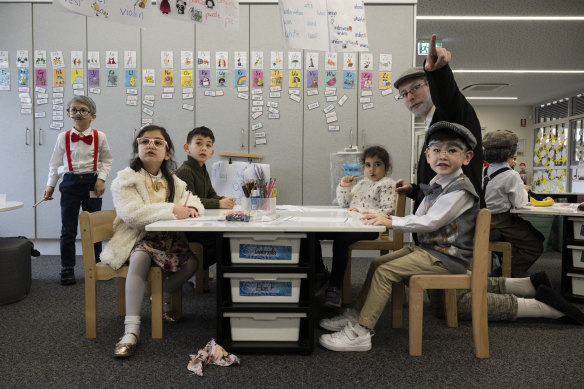By Mary Ward
Move over Book Week, Easter Hat Parade and Crazy Hair Day, there is a new dress-up event on the primary school calendar.
100 Days of School (also known as 100 Days of Kindy or Prep, depending on the state), is held on the 100th day of lessons for a school’s littlest learners, placing it in the final week of term 2 or the start of term 3.

St Patrick’s Primary School kindergarten students Levi Wiffin, Isaiah Chehab, Gabriella Yousif, Marcus Mieth and Jasmine Hammond dressed up for 100 Days of Kindy in Guildford, Sydney.Credit: Louise Kennerley
Barely heard of in Australia a decade ago, more and more schools have jumped on the trend, flooding school Facebook and Instagram accounts with pictures of kids wearing suspenders and cardigans, and sporting wrinkles drawn on their faces, as they dress up as if they are “100 years old”.
While some schools ask children to dress up or bring 100 of something – pieces of cereal, grains of rice – to class, others hand out certificates or have teachers dress up to surprise the students.
Retail has realised the market: In a post on its Instagram account last month, Kmart advertised a $9 child-sized “grandma wig”, encouraging its followers to “get ready for 100 days of school”. The store also sells a “100 days” cape.
100 Days of School has been marked in US classrooms for decades, where the day broadly aligns with when children have learnt to count to 100.
Since the mid-2010s, Australian teachers taking their inspiration from US-based Instagram accounts and teaching resources started to incorporate the day into their lessons. The event has rapidly gained momentum since school pandemic restrictions ended.

Children dress up as if they are 100 years old, while learning about the number 100 on the day.Credit: Louise Kennerley
St Patrick’s Primary School at Guildford, in Sydney’s west, first held a 100 Days celebration two years ago after staff saw it at a neighbouring school.
Children dress up and bring in 100 of something from home for a day of activities focused on the number 100.
The school’s assistant principal, Tracy Hoey, said parents and children “get right into” the event, with kids arriving at school with wigs, bowties, and carrying canes and reading glasses.
“Usually, it’s the same parents who go all out for Book Week,” she added.
But St Patrick’s kindergarten teacher Tasmin Higgins said many of the kids at their multicultural school had costume items borrowed from older members of their family.
“They just go and grab something. Then they come to school and say, ‘I look just like my Teta,’” she said.
At John Palmer Public School in Sydney’s north-west, the day begins with a disco, followed by a parents and carers assembly where children show off what they have learnt. In a twist on the theme, children dress as what they want to be when they grow up.
The school’s principal, Lisa Crawford, said the day provided an opportunity to show how much children had grown in their learning and personality throughout the first half of the year.
Early childhood academics were divided on whether the Australian adoption of 100 Days of Kindy was a good thing.
Associate Professor Jane Hunter, an education researcher at UTS Sydney, said there was already a lot to fit into a primary school year: Book Week, the Easter Hat Parade, athletics and swimming carnivals.
“I can see the merit in the sense that it teaches about measurement and history, but I just don’t know if, in the crowded curriculum, there is time for 100 Days,” she said.
Hunter said she was also concerned the dress-up elements may entrench stereotypes of older people in the community.
Victoria University Professor Mary-Rose McLaren said she had seen the day become more popular in Melbourne after pandemic restrictions ended.
“Our children in 2020 didn’t even get 100 days of school,” she said, “So it is nice to celebrate that.”
Opportunities for beneficial dress-up play also rapidly decline between preschool and primary school, McLaren added.
Christine Woodrow, an associate professor in early childhood education at Western Sydney University, was similarly in favour of an event commemorating the first half of a child’s school year.
“There’s a lot of transition that happens for children and families from home or early learning into kindergarten, and for lots of kids the expectation is high and scary,” she said.
“Taking stock about halfway through the year probably has a lot of merit. It’s also a good opportunity for engaging families.”
However, Woodrow suggested that perhaps schools could celebrate 100 Days with a focus on the present, rather than having kids dress up as the elderly.
“It becomes a matter of how it’s done rather than whether it’s done,” she said.
The Morning Edition newsletter is our guide to the day’s most important and interesting stories, analysis and insights. Sign up here.